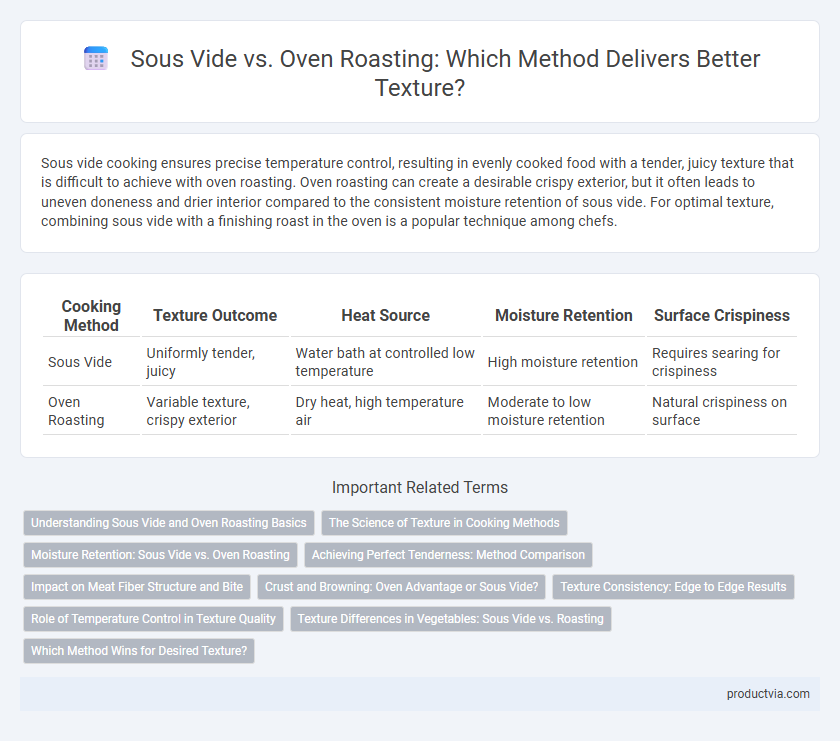Sous vide cooking ensures precise temperature control, resulting in evenly cooked food with a tender, juicy texture that is difficult to achieve with oven roasting. Oven roasting can create a desirable crispy exterior, but it often leads to uneven doneness and drier interior compared to the consistent moisture retention of sous vide. For optimal texture, combining sous vide with a finishing roast in the oven is a popular technique among chefs.
Table of Comparison
| Cooking Method | Texture Outcome | Heat Source | Moisture Retention | Surface Crispiness |
|---|---|---|---|---|
| Sous Vide | Uniformly tender, juicy | Water bath at controlled low temperature | High moisture retention | Requires searing for crispiness |
| Oven Roasting | Variable texture, crispy exterior | Dry heat, high temperature air | Moderate to low moisture retention | Natural crispiness on surface |
Understanding Sous Vide and Oven Roasting Basics
Sous vide cooking involves vacuum-sealing food and cooking it in a precisely controlled water bath, resulting in evenly cooked, tender textures by maintaining consistent temperatures. Oven roasting exposes food to dry heat, promoting caramelization and Maillard reactions that enhance flavor and create a crisp exterior with a varied texture contrast. Understanding sous vide's precise temperature control versus oven roasting's high-heat environment is key to choosing the ideal method for desired texture outcomes.
The Science of Texture in Cooking Methods
Sous vide cooking uses precise temperature control to break down proteins gently, resulting in tender, evenly cooked textures without moisture loss. Oven roasting applies dry heat, creating Maillard reaction-driven browning and a crispy exterior while potentially causing uneven internal doneness and firmer textures. The science of texture shows sous vide achieves maximum tenderness through controlled denaturation, whereas oven roasting enhances flavor and texture contrast via dry heat-induced surface caramelization.
Moisture Retention: Sous Vide vs. Oven Roasting
Sous vide cooking excels in moisture retention by sealing food in a vacuum bag, preventing evaporation and preserving natural juices during a controlled low-temperature bath. Oven roasting exposes food to dry heat, often resulting in greater moisture loss and a drier texture due to evaporation at higher temperatures. For optimal tenderness and moisture, sous vide provides a distinct advantage over traditional oven roasting methods.
Achieving Perfect Tenderness: Method Comparison
Sous vide cooking offers precise temperature control that ensures evenly cooked, tender meat by gently breaking down collagen without overcooking. Oven roasting delivers a crisp, caramelized exterior with a more traditional texture but risks uneven doneness and dryness if not carefully monitored. For perfect tenderness, sous vide excels in consistent moisture retention, while oven roasting enhances flavor and texture through Maillard reactions.
Impact on Meat Fiber Structure and Bite
Sous vide cooking gently heats meat at a precise low temperature, preserving muscle fibers and resulting in a tender, uniform texture with minimal fiber contraction. Oven roasting exposes meat to dry, high heat that causes more fiber shrinkage and tougher bite due to protein denaturation and moisture loss. The controlled environment of sous vide maintains juiciness and softness, while oven roasting produces a firmer bite with a caramelized crust from Maillard reactions.
Crust and Browning: Oven Advantage or Sous Vide?
Oven roasting excels in creating a crispy crust and rich browning due to direct dry heat, promoting the Maillard reaction that sous vide lacks. Sous vide ensures even cooking and tenderness but requires a final sear in a hot pan or oven to develop crust and color. For optimal texture with a crispy exterior, oven roasting or finishing sous vide dishes in an oven is essential.
Texture Consistency: Edge to Edge Results
Sous vide cooking provides superior texture consistency by evenly cooking food edge to edge at precise temperatures, resulting in uniform doneness throughout. Oven roasting often leads to variations in texture, with edges becoming crisp while the center can remain less cooked or dry. This precision in sous vide minimizes overcooking and ensures a tender, juicy texture from exterior to core.
Role of Temperature Control in Texture Quality
Precise temperature control in sous vide cooking ensures even protein coagulation, resulting in a consistently tender and juicy texture throughout the meat. Oven roasting, with its higher and less uniform heat, creates varying textures, typically a crispy exterior with a drier interior. The steady low-temperature environment of sous vide minimizes moisture loss, enhancing texture quality compared to the fluctuating heat of oven roasting.
Texture Differences in Vegetables: Sous Vide vs. Roasting
Sous vide cooking preserves vegetable texture by maintaining consistent, low temperatures that prevent cell wall breakdown, resulting in tender yet firm vegetables. Oven roasting promotes caramelization and Maillard reactions, creating a crisp, slightly chewy exterior with a softer interior. The controlled moisture retention in sous vide contrasts with the dry heat of roasting, which intensifies surface browning but can lead to uneven texture.
Which Method Wins for Desired Texture?
Sous vide offers precise temperature control, resulting in evenly cooked meat with a tender, juicy texture that is difficult to achieve with oven roasting. Oven roasting provides a crispy, browned exterior and a firmer texture but can lead to uneven doneness if not carefully monitored. For optimal tenderness and moisture retention, sous vide wins, while oven roasting excels for a traditional, caramelized crust and firmer bite.
Sous vide vs Oven roasting for texture Infographic

 productvia.com
productvia.com